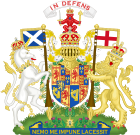Claim of Right 1689 facts for kids
| Act of Parliament | |

|
|
| Long title | The Declaration of the Estates of the Kingdom of Scotland containing the Claim of Right and the offer of the Croune to the King and Queen of England. |
|---|---|
| Citation | 1689 c. 28 |
| Territorial extent | Kingdom of Scotland |
|
Status: Current legislation
|
|
| Text of statute as originally enacted | |
| Text of the Claim of Right 1689 as in force today (including any amendments) within the United Kingdom, from legislation.gov.uk | |
The Claim of Right is a very important law passed in Scotland in April 1689. It was created by a special group called the Convention of the Estates. This group was similar to the Scottish Parliament. The Claim of Right is a key document for understanding how Scotland and the United Kingdom are governed. It helped shape the rights of people and the power of the government.
Contents
Why the Claim of Right Was Needed
The Glorious Revolution in England
In 1688, a big event called the Glorious Revolution happened. William of Orange arrived in England with his army on November 5, 1688. He came to challenge King James VII of Scotland, who was also King of England and Ireland. King James tried to stop William, but then he sent people to talk. Finally, King James left England on December 23, 1688.
Scotland's Unique Challenge
In England, a special Parliament declared that King James had given up his throne. They then created the English Bill of Rights and offered the crown to William and Mary.
However, Scotland faced a different problem. King James had not been in Scotland during this time. He also did not flee from Scottish land. This made it tricky to say he had "given up" the Scottish throne. The Scottish leaders needed a different way to decide who should be their king and queen.
How the Claim of Right Was Made
Deciding Scotland's Future
Because of this, a special meeting of the Scottish Estates took place. On March 16, 1689, they looked at letters from William and Mary, who both wanted the crown. On April 4, the Convention voted to remove King James VII from his position. They used ideas from a thinker named George Buchanan, who believed that kings had an agreement with their people.
Creating the New Laws
Later that month, the Convention agreed on two important documents: the Claim of Right and the Article of Grievances. These documents listed what the Scottish leaders believed were the necessary rules for Scottish law. They also stated that King James had lost his right to the Scottish throne because of his actions against these laws.
A New King and Queen
The Convention then offered the Scottish crown to William and Mary, based on these new documents. They accepted on May 11, 1689. They were then announced as King William II and Queen Mary II of Scotland. There was some discussion later about whether they fully agreed to all parts of the Claim of Right, especially those against the church system called Episcopacy.
Key Ideas in the Act
The Claim of Right includes several important statements about people's rights. Here are some of them, explained simply:
- Right to Challenge Laws: People have the right to ask the King and Parliament to review court decisions. This helps make sure laws are fair.
- Right to Petition: People have the right to ask the King for things. No one should be put in prison or punished for writing such requests.
- Regular Parliaments: Parliaments should meet often to fix problems, make laws stronger, and protect them. Members of Parliament should also be able to speak freely during debates.
- Protecting Rights: The people demand and insist on all these rights and freedoms. No future actions should ever harm these rights. Any punishments like fines, loss of jobs, or imprisonment should be looked at, and those who were wrongly treated should get help.
Why the Claim of Right Is Still Important
Strengthening Parliament's Power
The Claim of Right helped to make the Scottish Parliament stronger. It limited the power of the King. This law was confirmed by the Scottish Parliament in 1703. When Scotland and England joined to form Great Britain in 1707, the Parliament of the United Kingdom kept this Act.
Modern Day Use
Even today, the Claim of Right is sometimes used in legal discussions. For example, in 2019, some politicians used this Act in a court case. They argued that the Prime Minister's decision to temporarily close Parliament was against the law. The court looked at the Claim of Right as part of its decision. While the case went through different courts, it showed that this old law can still be important in modern legal challenges.

